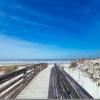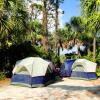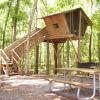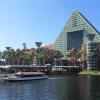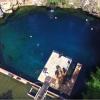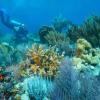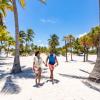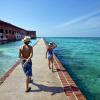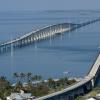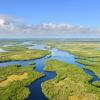Mellow. No other word can better describe the serenity I felt while plunked in a beach chair as the setting sun melted into the horizon. I almost didn't notice the fishing line tightening and the rod tip twitching.
A jolt of electricity snapped my trance. I reached for the rod perched next to me, the holder's spike deep in the sand. Another rod twitch and... Ka-Boom! A solid hookup on a redfish that I could tell had serious proportions. Upon gobbling a little morsel that mysteriously became Super Crab, the startled red streaked toward Cuba.
After a seesaw battle, I finally removed the hook and watched the redfish regain energy and swim off, no worse for the wear.
Fishing the surf and coastal areas of Florida seldom disappoints. And when you consider that Florida's mainland offers 1,800 miles of coastline, it's not hard to get your share of the action.
Surfcasting the Beaches
Of the two main styles of surfcasting (from beaches or regular shorelines), fishing with the feel of sand between your toes is the most popular. But a few tips will improve your odds of success.
- Look for points of land where a finger of sand jutting into the water changes the current flow, which often forms eddies that hold small bait fish. Toss your bait past the eddy and let the current sweep it through naturally.
- Washouts represent places where the tide has come up higher onto the beach than normal. Using live bait such as a shrimp, cast where the next wave will sweep it into the surf.
- Troughs are areas between the shoreline and sandbars where larger species cruise in search of an unsuspecting crab or careless minnow. Cast parallel to the water's edge into the trough and work the lure back with the current.
Excellent baits include live sand fleas, pinfish, menhaden, fiddler crabs and shrimp, but you'll still catch plenty of fish on cut baits, lures, jigs and flies. Gear should be in the four- to eight-pound class for most fish since few obstructions are usually present. Tackle shops sell beach rod holders for the leisurely; if fishing deeper water, use a level-wind reel with a heavy pyramid weight attached above the leader so you can cast the bait beyond where the waves crest.
Top east coast surf-casting beaches include Miami Beach (south end), Pompano Beach, Cocoa Beach, Ormond Beach and Fernandina Beach. West coast hot spots are Cape Sable, Bonita Springs, Indian Rocks Beach, Carrabelle, Mexico Beach, Gulf Breeze and Fort Walton Beach. Virtually all islands from Marco to Pensacola offer fabulous surf fishing.
Shoreline Surf-Casting
Non-beach shorelines that feature rock outcroppings, grass, sand or mud can be very fish-friendly. To select the best shorelines, glance seaward or even wade out a bit and determine if the area possesses what game fish want: groceries. If a food supply is present, so too are redfish, tarpon, snook, trout and the like.
- To determine if crabs, shrimp and the like are around, look for the food chain a step higher: wading birds, pelicans, cormorants, stingrays and small sharks.
- Watch a low-flying bird and see if it suddenly "humps" (ascends) - it may have spotted a large fish just ahead like a shark or redfish.
- Low-flying birds scare schools of bait fish, causing noise and splashing that gives away their presence.
Go with 12-pound line to deter abrasion from rocks, and use bobbers if enough depth to keep baits above obstructions. All live baits work well and same with top-water plugs and flies. If using a regular lure, work it a bit faster so it doesn't get hung up.
Areas offering quality surf-casting opportunities on the east coast include the Florida Keys, the Indian River Lagoon system and St. Johns River; on the west coast, Estero Bay, Charlotte Harbor, Tampa Bay and Steinhatchee.
No matter where you plant your feet on Florida's coastline, remember that fish can sense the slightest noise or vibration. Walk lightly, cast far ahead and get set for the special action and attraction of surf angling.
For license information, visit MyFWC.com/license.

